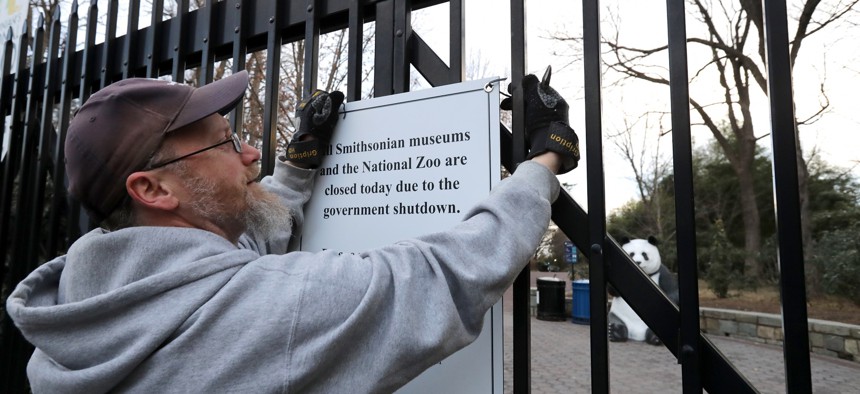
A Smithsonian National Zoo employee removes a sign telling visitors that the zoo is closed due to a government shutdown from the front gate on Jan. 28, 2019. Chip Somodevilla / Getty Images
With shutdown uncertainty still in the air, agency leaders need plans to support employees, expert says
The federal budget process is awash in volatility following the ouster of House Speaker Kevin McCarthy, and one health expert says agency leaders should not just plan for a shutdown, but also how to best support their employees through one.
Tifani Gleeson knows what it is to be a worker navigating the threat of government shutdown, she’s been there as an active-duty service member or contractor since 2004, and each time, she has seen contrasting effects of increased workloads or financial strain on excepted employees.
“I’ve been one of the people left working without pay during a shutdown,” said Gleeson, chief medical officer for contracting firm Sedgwick Government Solutions and a former Navy and Marine Corps occupational physician.
“I think even as a community — and especially here in the D.C.-area, where most of us have neighbors, friends that are going to be directly impacted by this — is being supportive and understanding that this is going to be a unique experience for each individual, whether they are working or not working, continuing to get pay or potentially working without pay," she said.
Though the potential of a government shutdown has been temporarily averted with a continuing resolution through Nov. 17, the current legislative situation is anything but stable and predictable.
Since Tuesday’s ouster of former Speaker Kevin McCarthy, R-Calif., it’s unclear how and when the House will move forward with drafted spending bills and whether there will be enough time to negotiate a budget deal with the Senate.
That leaves federal employees and contractors to traverse the familiar preparation of a possible government shutdown and the unprecedented chaos playing out on Capitol Hill.
In the midst of this uncertainty, Gleeson said it would be wise for agency leaders to refine the shutdown contingency plans developed in recent weeks and to touch base with employees navigating current uncertainty.
“They do need to acknowledge the situation we’re in, we don’t want to pretend it’s not happening,” she said. “Part of that is having these conversations with your employees, making sure they are aware of what resources are available to them, encouraging them to talk to their financial institutions about what sort of low-cost or no-cost loans may be available to them.”
She added that agency leaders should also identify and communicate what benefits might be potentially impacted by a shutdown and how excepted employees might be affected by the essential operations they will be tasked with carrying out.
Though federal employees are now guaranteed back pay following a shutdown because of the Government Employee Fair Treatment Act of 2019, there are still potential financial hardships during a budget impasse and federal contractors are often not compensated for lost revenue.
During the 2018-2019 partial government shutdown, federal employees collectively saw $9 billion in wages delayed during the 35-day budget battle, according to the Congressional Budget Office. While they ultimately received back pay, employees were either furloughed or worked without income, leading some to seek help from efforts like a mortgage assistance program for federal workers established in Denver.
Because of these disruptions, Gleeson said it was important for agency leaders to communicate as much as possible with excepted employees to help navigate productivity and wellness challenges resulting from a shutdown.
“It’s challenging because you may have a larger scope of control as a leader and be responsible for more people, so it’s an increased challenge to get a pulse on your workforce and individuals to know when they might be struggling,” she said. “Putting plans in place to be able to have still direct contact with a leader so people know that they can reach out and have those conversations, making sure they know what resources are still going to be available to them and trying to maintain as positive an environment in the workforce as possible. I think the leader’s attitude going into this can be really impactful.”
The other thing to adjust for is the potential of increased injuries and workers' compensation issues that could arise with excepted employees because of a shutdown.
“I think that’s a big area to focus on during this planning,” Gleeson said. “And that’s everything from, ‘How are we going to maintain facilities’ to ‘Who’s going to respond to water spills so we don’t have trips and falls?’ Some of it’s in the weeds. We need to have down to that level planning to maintain that safe workplace.”
If there is one benefit for excepted employees is the post-pandemic rise of telehealth services that can be utilized to support physical and mental health, alongside remote practices to help employees and leaders stay better connected and supported.
“Of course, a lot of that messaging needs to come out ahead of time because you will lose some amount of contact if there is a shutdown,” Gleeson said.







